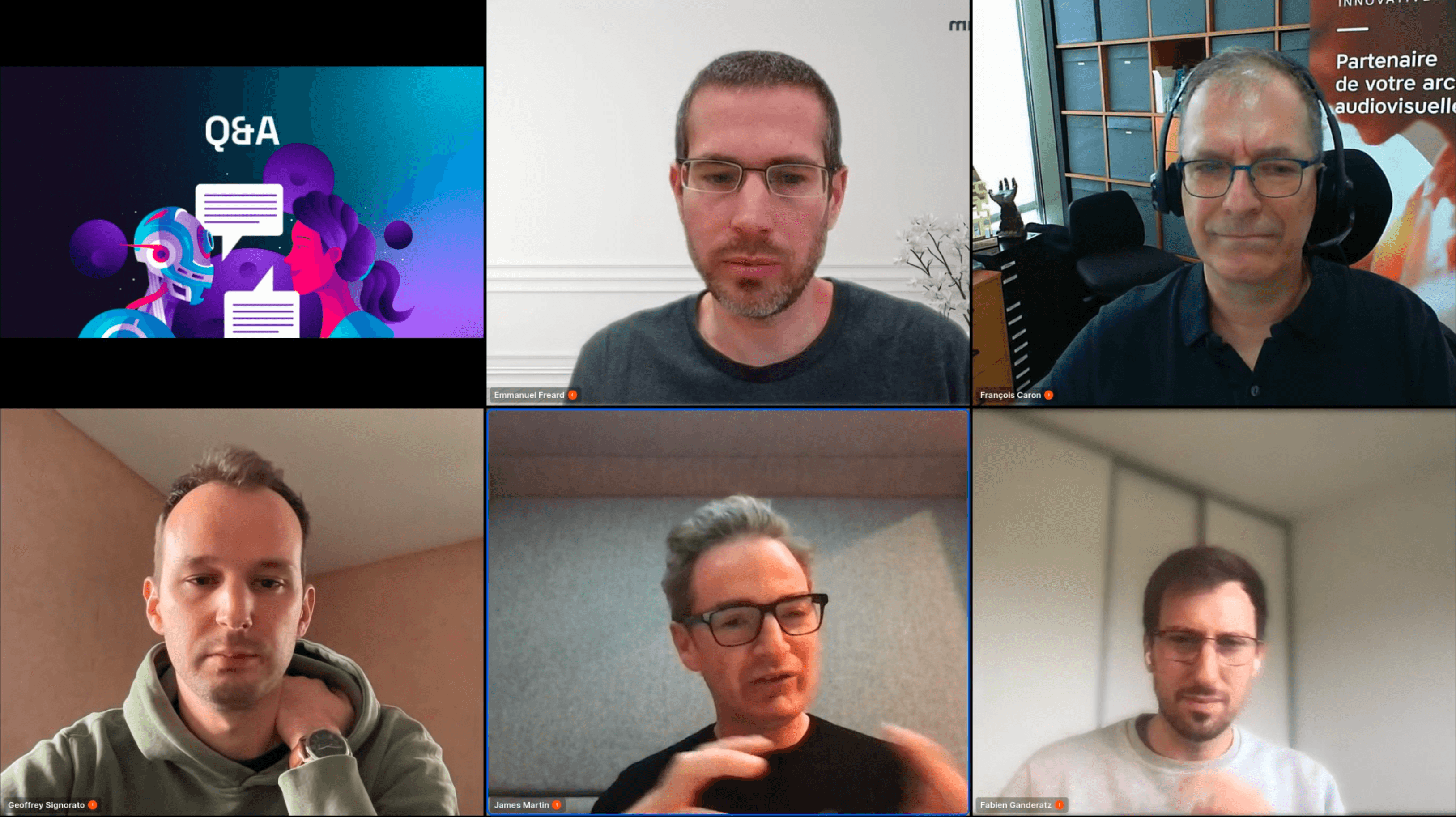How to optimize your cloud infrastructure for video streaming and encoding - Webinar report

Today, the cloud is an essential part of video processing. Naturally, when you consider Netflix and YouTube alone accounted for over a quarter of global web traffic in 2022. Furthermore, that and related activities are set to grow: IT spending in the global media and entertainment sector rose by 34% between 2019 and 2024, according to Gartner.
What do these trends imply for companies in the sector today, particularly for video companies? We brought three of them together for a dedicated webinar late March 2024. Here are the highlights!
"I've been in the video sector for 18-20 years, notably on the VLC, FFmpeg and x264 projects," said Jean-Baptiste Kempf, president of VideoLAN and inventor of the pioneering VLC open source player, by way of introduction. "Today, all video found on the cloud and on websites is managed by open source projects, whether it’s on Facebook, YouTube or Twitch. This is one of the few areas of the cloud where there is virtually no non-open source competition, and all proprietary solutions are based on these solutions. But it's true that today you need significant resources for transcoding - so a lot of computing power - and adapted infrastructures that are capable of scaling according to your needs at certain times. So the importance of cloud providers is paramount."
Our three speakers then presented their solutions.
Emmanuel Fréard, Co-Founder and CTO of blastream, presented his cloud-based livestreaming service, which enables events to be produced and broadcast directly over the web. "It’s a sort of mini-OBS in the cloud, controlled directly from the web, similarly to what our American competitors, such as StreamYard, offer," explained Fréard. Blastream has the particularity of being white-label, which makes it suitable for uses such as webinars, but also live shows, as well as special activations like the broadcast of a remote-controlled car race, with Orange. To achieve this, blastream relies on MCU technologies, with ingestion and broadcasting notably via WebRTC. On the cloud side, blastream depends on the reliability and availability of Scaleway's CPU resources - "we have an average of 25 seconds of instance availability, which is very comfortable for our customers and end users", asserted Fréard - as well as the sovereign aspect, as video data must remain RGPD-compliant at all times.
Geoffrey Signorato, Lead Developer at Streamfizz, then presented this video streaming platform created in 2012, by parent company Webcastor. Streamfizz features a responsive, customizable player and alternative to GAFAM solutions, with a strong focus on data confidentiality. Indeed, Streamfizz's cloud configuration "ensures that videos are not sent to services outside France", explains Signorato; "this is why Streamfizz has developed its entire encoding system in-house". This system consists of uploading video files to object storage, before passing them on to a pool of 3070 and RENDER-S GPUs in a private network for encoding and subtitling, before they go back to object storage. Streamfizz also relies on Scaleway's Kubernetes Kapsule to manage scale-up and scale-down of GPU Instances.
François Caron, CEO of EMPREINTE.COM, then explained how this "pioneer in online video" began in 1989, producing CD-ROMs for Wanadoo (France Télécom), before moving on to webTV, streaming, display and webinars. To do this, Empreinte relies on Scaleway Kapsule, Load Balancer, Object Storage, Container Registry and MySQL, enabling it to meet substantial load requirements, such as 70,000 simultaneous users for one customer, or 3,000 multilingual live broadcasts per year for another. Caron was particularly pleased that his sector had created 40,000 jobs to date - "we have talent in this country, and applications that are used worldwide" - while regretting that said players "don't talk to each other enough."

Why sovereignty comes first with video
Sovereignty being the common ground between these three players, the discussion part of the webinar began on this topic. "It's a determining factor", insisted Caron, particularly when managing the video content of clients’ intranets, as is the case with Empreinte. "Some servers are in the US, which can reveal confidential information. CIOs don't want to look at this sort of thing... except when we talk to them about cybersecurity. Controlling cloud perimeters as tightly as possible is decisive for security."
It's also a key sales argument, according to Signorato. "It's a real selling point to be able to tell our customers that we know exactly where their video will go when they upload it. We know that it stays in France, who encodes it and where, where it's uploaded... Sovereignty is not something clients think about by themselves, but when we tell them about it, it tends to reassure them."
In addition to reassuring customers, **sovereignty is "mandatory for some customers", according to Fréard. "Some CIOs impose it. And that's fine with us!” **he said. “We prefer to work with people we can talk to, which isn't always the case for non-European companies. It's a sales pitch, but also a technical one, and one that has real added value for us as a startup."
Availability and flexibility: the keys to success
Fréard then returned to his need for guaranteed CPU Instances available within 25 seconds. "We don't want to have a whole pool of servers available at all times and only use them 10% of the time. We prefer to call on resources at a moment's notice", he said. “This makes economic and environmental sense. And the faster these resources are available, the better it is for the end customer.”
This need for flexibility is covered for Streamfizz by Kubernetes autoscaling, "which allows us to define a minimum of replicates that will run on Instances", explained Signorato. "Whenever Kubernetes receives a CPU or RAM load, the autoscaler will automatically switch on Instances," he added. "This elasticity allows us both to manage peak loads, and to limit resources to the minimum" when Streamfizz doesn't need resources. “There's a whole configuration to be done in advance, but once properly set up, we have a certain robustness on production."
"We're trying to do better with less", summarized Empreinte's CEO. Last year, the company’s sales grew by 40%, while its cloud bill fell by 50%, "simply because we managed [resources] better", explained Caron. "Application optimization, intelligent dispatch management, multi-operator operations, transparent disaster recovery, scalability management, switching to object-oriented activity... all help in making considerable savings, and in having increasingly reliable applications."
These aspects of FinOps are concerns of many customers, confirmed Fabien Ganderatz, Solution Architect at Scaleway: "we make a point of allowing customers to consume as they wish, when they wish, and as quickly as possible, in terms of resource activation."
GPUs, CPUs, and cost optimization
As Signorato has already explained on our blog, the switch from CPUs to GPUs for video encoding has brought Streamfizz considerable advantages in terms of time and cost. "To encode video with CPUs, you need to quickly access a lot of computing power," he said during the webinar. "In our V2, we decided to go with GPUs. They take a little longer to start up, but they handle video tasks much faster. Thanks to that, plus relying on Kubernetes for scale-up/in, we achieved four times faster encoding for four times cheaper [with 3070 GPUs], at almost the same quality as with CPUs." Streamfizz also uses RENDER-S GPUs to do transcription and create subtitles automatically.
Last but not least, the company is currently testing NVIDIA's new L4 GPUs, and "the results are rather encouraging; we're getting the same quality, almost the same encoding time, but at a lower cost, since the GPUs are cheaper, and above all billed by the minute,” said Signorato. This last point is very important, because with GPUs billed by the hour, you could end up paying an hour for just ten minutes' use.
But in the end, between CPUs and GPUs, which one wins when it comes to video?
"In terms of encoding finesse, GPUs don't outperform CPUs," said Caron. "GPUs go faster, but do some things less well for that reason. And when you want to process the remaining 20%, it consumes 80% more energy [than a CPU]." Empreinte therefore relies mostly on CPU Instances, except when customers have specific needs.
As for Fréard and blastream, "for real-time encoding, we've found that with GPUs, we can increase encoding power. Whereas with CPUs we can go up to [a resolution of] 1080p and 30 fps [frames per second], with GPUs we can reach 4K [ultra-high resolution]. Except that streaming in 4K on the web today doesn't make much sense, at least not live, especially as there are significant environmental impacts. But here's the thing: in specific cases, GPUs help us - those who stream with OBS can test this themselves - but we stick with CPUs in most cases."
In conclusion, these three apparently similar French players have three very different practices when it comes to GPUs and CPUs. As Caron pointed out, "this is a good illustration of the market!" What's more, "it's constantly evolving," added Signorato.
In any case, the recent integration of ARM CPU nodes into Scaleway's Kubernetes offering will open up new perspectives for video orchestration, Ganderatz pointed out. A development made all the more interesting by the fact that ARM will open up new possibilities in the field of video, he added.
Future video trends
When it comes to the future of video on the cloud, "we're not sure of anything yet," said Signorato, while acknowledging that ARM remains an interesting new field to explore.
"On the encoding side, there are certainly things coming," said Fréard. "HEVC [High Efficiency Video Coding] is interesting; and the predictive aspect will certainly emerge. I've seen that Opus has included predictive on its audio codec, and so maybe other codecs will do the same."
"The big challenge for video is to be green," Caron insisted. "Since we've lowered our cloud consumption by 50%, we’d like this trend to take off internationally."
Fréard concluded in this vein, highlighting French expertise in the video field - as evidenced by Jean-Baptiste Kempf. He also stressed the importance of movements such as Greening of Streaming, and that of reducing the environmental impact of streaming globally. One to watch moving forwards!